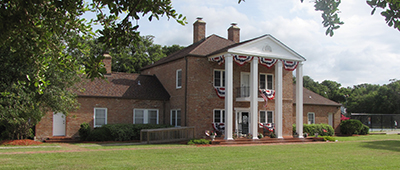
In 1745 Governor Gabriel Johnston ordered that construction begin on a fort at the mouth of the Cape Fear River, to serve as protection for the lower Cape Fear and for the town of Brunswick. Fort Johnston, which was not deemed officially complete until 1764, was designed to respond to threats from both Spanish and French forces along the coastline of North Carolina. The fort played an integral role in the Stamp Act crisis, the Revolutionary War, and the Civil War. Today, all that remains of the fort are the officers’ quarters.
Construction on Fort Johnston began in 1748 in what was long known as Smithville and is today known as Southport. From the beginning construction was hampered by a variety of factors, the first of those being a long-feared attack by Spanish ships in the summer of 1748. Although Governor Johnson personally decreed the fort complete in 1749, at the time it had limited resources and did not meet the requirements of its original conception. Work continued until 1764; by that time though, ironically, the fort’s initial reason for being, that being to dispel Spanish and French forces, was no longer necessary.
Fort Johnston was threatened in 1766 by armed American resisters to the Stamp Act, responding to the British seizure of two mercantile ships. From 1766 until 1775, the fort existed fairly peacefully, providing protection to the lower Cape Fear River basin. With the growing animosity between American colonists and the British Crown in the early 1770s though, the Fort came under attack again. In May 1775, Royal Governor Josiah Martin, fled his own palace to seek protection at Fort Johnston. He eventually escaped an American attempt to overtake Fort Johnston, having learned of the plan ahead of time. After Martin’s escape, a group of Whigs, led by John Ashe and Cornelius Harnett, seized Fort Johnston in July 1775 and burned it to the ground. The torching marked the first active violence against the British in North Carolina.
Between 1794 and 1809, the new federal government rebuilt Fort Johnston. The fort soon was passed in importance by the new Fort Caswell, which was built in 1825 on nearby Oak Island. During the Civil War though Fort Johnston was part of the Cape Fear Defense System, and contributed to the Confederate protection of Fort Fisher. Following the war, the fort fell into disrepair, but eventually the officers’ quarters were revitalized.